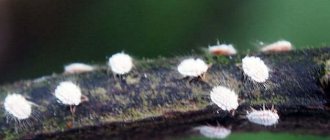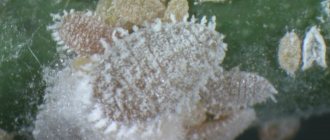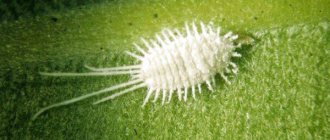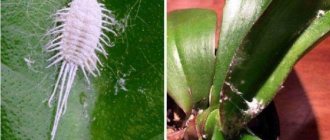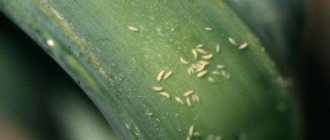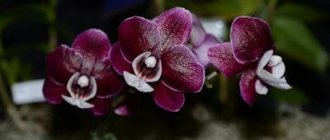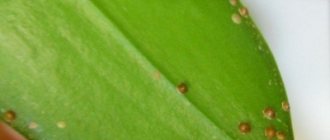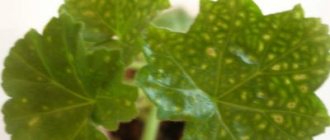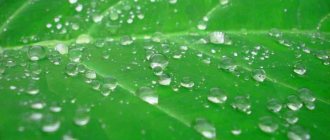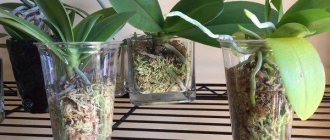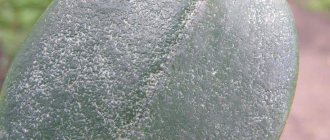Exotic orchids, previously unknown in our country, are increasingly being bred by fans of this flower on their windowsills. Despite the external vulnerability and fragility of the roots, these plants easily adapt to new conditions and tolerate the dry climate of apartments well. However, they are also susceptible to diseases and attacks from harmful insects. The most common one is the mealybug.
There is a lot of information about this pest on the Internet, accompanied by photos and videos. What to do if a mealybug appears on an orchid, how to get rid of it using the most effective methods - find out from this article. It is important to remember that it is impossible to cure a plant from a parasite. You just have to fight it: remove it, destroy it, and then take careful precautions so that it doesn’t appear again.
Types of mealybugs living on orchids
Mealybugs (false beetles, felt bugs, “hairy lice”) are a large family of hemipteran insects that are absolutely unrelated to worms. Many ignorant gardeners mistakenly confuse them with scale insects, although they are completely different.
The insect has a large oblong body (about 3-7 mm long), white or beige, which is covered with a waxy coating reminiscent of flour. On the sides it is evenly surrounded by bristles of several millimeters, and at the back it has two pairs of more elongated hairs.
Several hundred species of scale insects are known, but only three of them are dangerous for orchids:
- bristly - females are slightly red in color, dusted with “flour”. Males are like flies and fly;
- citrus - females are slightly pink in color with a light bloom. They leave honeydew (a sticky sweet secretion) on the orchid. Males are brown and capable of flight;
- seaside - females are gray-pink, males have wings.
Important: the pest most often affects the roots of plants, and also secretes a specific waxy secretion, which promotes the development of fungal diseases and prevents it from being destroyed by chemicals.
Briefly about white bugs
Mealybugs, also known as hairy lice (colloquially), are named because of their cotton-like white discharge. It is not difficult to detect an insect on a plant; it is clearly visible to the naked eye.
Characteristics of mealybugs:
- average size 2.5 to 6 mm;
- oral apparatus sucking;
- the insect is covered with a white powdery coating;
- lays eggs, high fertility;
- The optimal temperature for reproduction is about 25° C.
A white fluffy lump found on an orchid is a cause for concern.
Danger to plants
Males are safe for the flower because they die after mating. Females are real parasites. With their mouthparts, they gnaw holes in the vine, sucking on it, drawing out life-giving juices, and building nests resembling cotton balls in the recesses of the leaves. In addition, they actively occupy stems and leaves, moving onto pots, windowsills and windows, covering everything with a cobwebby coating along the way. It blocks the stomata of plants, preventing them from “breathing,” spoils the appearance and depletes the flower.
In addition, having discovered a white sticky coating on an orchid, amateur flower growers often do not know how to treat and remove it correctly and may make mistakes when dealing with feltworm.
Female scale insects are extremely fertile. Laying is done up to 4 times a year. After 10 days, grayish larvae hatch and move quickly, choosing a place to feed. The insects are like fluff and can easily be transferred between plants even by weak air currents. They stick to the tender parts of the leaf, feed greedily and grow quickly. Before becoming an adult, they go through several molts.
This is interesting: there is an opinion that the wandering louse survives only on weakened plants - those that are dormant (in winter), have recently been exposed to disease, or have been attacked by other parasitic insects. And also as a result of improper care or depleted, long-unchanged soil.
What insects can appear in the soil?
A wide variety of insects can live in the substrate: wood lice, millipedes, spiders, ants, cockroaches, snails. The ones listed below manifest themselves most often.
Thrips
Thrips are small black creatures, sneaky and fast, almost elusive . As they move, they leave a trail behind them - silvery paths and many black dots on the leaves.
Fools
They are typical inhabitants of moist substrates. Most often, their presence is extensive in orchids that grow in moss. They are also extremely fast and nimble.
Podurs cause very significant damage to the plant, sucking out vital juices, as well as gnawing young and fresh shoots, not allowing the plant to develop and grow normally. They deteriorate the overall health of the flower.
Symptoms of pest damage
This pest is difficult to confuse with anyone else. There are several signs of the appearance of an uninvited “resident” when it is difficult to detect:
- sticky leaves and white coating on the orchid;
- motionless white tubercles (clutches in which females hide);
- sticky drops on stems and leaves;
- mold or the beginning of rotting of the plant;
- changed size and color of its various parts;
- “marbled” leaves interspersed with pink and yellow.
Prevention
All plants need to be inspected regularly, especially young shoots and leaves, buds and flowers, since these are the parts that most attract mealybugs.
It is also important to maintain proper care for the orchid - you need to monitor the temperature, air humidity and ensure proper watering. Particular attention should be paid to orchids in winter.
Often beetles enter the house along with a new plant. To avoid this problem, you should carefully inspect your green pet before purchasing. If it is not easy to notice small bugs in the peduncles and core of an orchid, then it is impossible to detect them in the soil, so at home a pot with a just purchased orchid should be immersed in a basin of water for five minutes. The water should almost cover the surface of the substrate. After the specified time, pests, if any, will come out of the soil. It also makes sense to quarantine each new plant for a month.
What causes orchid infection?
A fluffy, harmful bug can very rarely appear on flowers that are properly cared for. A healthy plant diligently produces special substances that repel insects.
Favorable conditions for the appearance of parasites are sometimes created by flower growers themselves. The most common of them:
- Lack of hygiene. Phalaenopsis needs regular moisturizing spraying, wiping leaves and showering. Without these procedures, the flower withers and weakens.
- Contaminated soil. Low-quality substrate may be affected by mealybug larvae.
- Violation of the humidity regime. Overdrying, as well as overwatering, negatively affects the condition of orchids and reduces their immunity.
- Failure to comply with the quarantine of new flowers. All purchased plants must be kept separate from the rest for at least a month.
- Low lighting. Lack of light is favorable for the development of insects.
The scale insect is carried indoors by people, animals and even ants. This is why keeping the plant clean and maintaining proper care and hygiene is a top priority.
Possible places and causes of parasites
On the entire surface of the plant. At any stage of development, the insect is very mobile and moves well in any direction.
Interesting! A healthy orchid secretes pheramones that repel pests. Weakened specimens are attacked.
The most favorite habitats are leaf axils and buds.
Young shoots with a fragile skin are easily damaged and are most suitable for obtaining juice. Mealybugs willingly colonize secluded areas at first. Some types of white beetles parasitize in the soil, damaging aerial roots.
How to get rid of mealybugs on an orchid
If a white coating is found on the orchids or insects of the same shade are found, then the owners of the flower urgently begin to look for ways to escape from the uninvited and dangerous guest.
Fighting scale insects is not as simple as it seems. It is difficult to breed the insect: it covers its habitat with foundation (wax), which protects the individual from aggressive environments. Sometimes you have to get rid of the parasite several times.
First of all, the plant needs to be isolated from the rest as soon as possible and carefully examined. And then look for a suitable method of treatment and remove the sticky white coating that has appeared on the orchid.
Mechanical removal
As soon as a hairy louse is found on an orchid, you should immediately begin manually cleaning the plant from the bug, its clutches and larvae, following the following procedure:
- damaged leaves and peduncles should be cut off;
- use tweezers and a cotton swab to remove insects from the leaf axils;
- wipe the leaves with a damp cotton pad;
- remove scales on the pseudobulb of the plant;
- bathe the orchid in the shower;
- disinfect the windowsill and window on which the diseased flower stood.
After all the manipulations, it is best to transplant the orchid into a new, high-quality substrate, since water washes invisible insects into the soil, simultaneously infecting the roots.
Before transplanting, the leaves and bulb must be treated with a soap and water solution. To prepare it, grate laundry soap on a coarse grater and add warm water in a ratio of 1 tsp. for 1 l. The mixture is thoroughly beaten until foam forms, which is used to wipe the plant. At the same time, the leaves must be treated with the utmost care - during illness they are extremely fragile.
Mealybugs are very tenacious. That is why, along with mechanical removal, chemical (for large accumulations of felt grass) and folk (for small lesions) control methods are used. Each of them will be discussed next.
Chemicals
To completely get rid of felt weeds, two types of chemicals are used:
- intestinal action (the insecticide saturates the plant tissue and destroys the females through the juice, since the wax on the surface of the body protects them from external agents);
- superficial (contact) action (designed for larvae and eggs that are not covered with wax).
The most effective drugs that have proven themselves on the market are:
- “Vertimek”, “Fitoverm” - bio-insecticides with an efficiency of about 98% (0.5 ml per 2 l);
- "Aktara" is a systemic drug. Can be added to water for irrigation, and its period of action will extend to 60 days (1.5 g per 2.5 l);
- “Calypso” - begins to act in the first hour, protects against pests for up to 30 days (0.5 ml per 1 l);
- “Actellik” is a surface treatment with a long period of action (2 ml per 1 l);
- “Mospilan” - a pesticide that kills adult insects, larvae, clutches (2.5 g per 1 l + 10 l);
- “Bankol” is odorless, non-toxic to people and animals, after treatment it is valid for up to 14 days (0.5 g per 1 l).
The market for chemicals against pests is constantly evolving, so it is quite possible to find other effective modern preparations on the shelves of flower shops.
After treatment, it is recommended to cover the plant with a plastic bag and leave for half an hour - the product will act on the bugs faster and more aggressively.
The listed chemicals are slightly toxic to humans, but you still need to work with them using individual protective methods - a respirator, goggles, gloves. After processing, be sure to:
- wash exposed skin, hands and face with soap;
- if the chemical is spilled on the skin or gets into the eyes, they should be thoroughly rinsed with clean running water;
- Rinse your mouth with water several times.
Important: if the drug used is ineffective, the new drug can be used no earlier than 10 days later.
Traditional methods
Home methods for combating the parasite are varied, and sometimes no less effective than chemicals. It is possible to remove bugs from “occupied territories” with the following solutions:
- oil emulsion: 1 liter of warm water + 1 tsp. soap shavings (black or green laundry soap);
- soap-alcohol emulsion: 20 g liquid soap + 20 g medical alcohol + 1 liter of warm water. Leaves can be sprayed or wiped;
- garlic infusion: 0.5 liters of boiling water + 3-4 cloves of garlic (finely chopped), leave for at least 12 hours. After the specified period, strain into a half-liter jar through several layers of gauze, add water to the original volume. Spray the leaves above and below;
- onion infusion: peel a medium onion, chop finely, pour a glass of warm water. Leave for 4 hours, strain. Spray or wipe the plant;
- hot pepper decoction: 50 g hot pepper (chopped) + 0.5 liters of boiling water, cook for 5 minutes. Cool, strain, process;
- infusion of pyrethrum (Dalmatian chamomile): chop 200 g of inflorescences with herbs + 2 liters of boiling water. Cover with a lid and leave for 12 hours. Strain, dilute in a ratio of 1:3 (part infusion, three parts water), begin processing;
- alcohol infusion of calendula: wipe the leaves of orchids in the evening so that they are not burned by the sun;
- frequent spraying with mash: 0.5 liters of water (warm) + 1 tsp. liquid dish soap. You need to take the cap of a plastic bottle and drill a small hole in it. Pour the mash into a container and treat the plant 5-6 times a day, especially stopping in places where the pest accumulates.
The treatment is considered successful if within a month the insects on the orchid die and do not return.
Prevention
And yet, no matter how high-quality and effective pest control methods are, it is still better to prevent their occurrence.
In order for the hairy louse to avoid flower crops, several simple conditions must be observed:
- high humidity around the plant (regular spraying, containers with water near the pot);
- hot shower (35°C) in the bathroom every week;
- in winter, provide additional lighting and do not use nitrogen fertilizers;
- Wipe the leaves daily with a damp cloth or cotton pad. You can add succinic acid (1 tablet per 1 liter) or Epin (according to the instructions) to the water;
- do not over-moisten the soil.
You should take the fight against pests that attack the orchid seriously. If the treatment instructions include several stages, it is not advisable to neglect them. It is necessary to follow each point clearly and strictly.
It is worth remembering that white furry bugs can appear on orchids again at any moment, but you now know how to quickly get rid of them. Carefully inspect the plant more often, carry out preventative measures, and the beautiful flower will not be afraid of parasites.
Preventive measures
Pest control consists not only of their destruction, but also of following certain rules to prevent the appearance of bugs on orchids. When growing these flowers, it is very important to adhere to the following preventive measures:
- When purchasing a new orchid, you must quarantine it away from other plants. It is necessary to monitor it daily, and if pests appear on the leaves, immediately begin treating with insecticides;
- Buy soil only from trusted suppliers . It must be treated against fungal infections and pest larvae. When buying soil for orchids in a store, it is better to steam it before use or heat it in the oven at a temperature of 80-85ºC;
- Do not take orchids out into the open air in the summer, as the risk of pests attacking indoor and garden crops is very high. It is also better not to leave flowers near an open window;
- Proper care of the plant will ensure its viability and high immunity; pests rarely settle on such a plant;
- Daily inspection of plants will allow you to timely detect pests before they have time to multiply and completely destroy them.
Why might they appear in the ground?
To a large extent, pests reach the plant through the soil. After all, one way or another, the soil contains quite a lot of different organisms that initially live there because of the comfortable environment for reproduction and existence.
Therefore, when purchasing soil for a plant, you must be prepared for the fact that you will have to deal with pests located there. Moisture also actively helps bugs and midges to reproduce, so you should not overwater the plant, because this can only provoke pests even more.
Chemicals to control mealybugs
It happens that the use of folk remedies does not bring the desired results, then flower gardens resort to chemical ones. All chemicals whose action is aimed at controlling pests are called insecticides. They are divided into the following types:
- Contact - the action of such insecticides is carried out by penetration into the pest’s body through the skin. Due to its strong effect, plants treated with this product do not need to be re-treated. While the flower is being treated with a contact preparation, the plant must be protected from sunlight, otherwise this may lead to yellowing of the leaves.
- Intestinal - such insecticides enter the parasite’s body through the mouth.
- Systemic - the effect of such drugs is that when the chemical gets into the root system and leaves of the orchid, it makes the plant sap poisonous to pests. Such products are usually sold in the form of a spray, so in order not to overcool the plant, you need to carefully study the instructions for use before use.
Preparations for combating scale insects can be made from oil. Such products should be applied only to areas affected by the parasite, otherwise harm to the plant may occur. Leaves coated with an oily preparation should not be left in the sun.
Adult mealybugs are weakly affected by drugs
